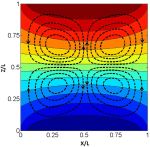EPJ E Highlight - Thermodiffusion in weightlessness
- Details
- Published on 20 October 2014

Zero gravity experiments on the International Space Station shed some light on thermodiffusion effects, relevant to the oil and gas industry and global warming prevention processes
Thermodiffusion, also called the Soret effect, is a mechanism by which an imposed temperature difference establishes a concentration difference within a mixture. Two studies by Belgian scientists from the Free University of Brussels, recently published in EPJ E, provide a better understanding of such effects. They build on recent experimental results from the IVIDIL—Influence Vibration on Diffusion in Liquids—research project performed on the International Space Station under microgravity to avoid motion in the liquids.
In the first study, using a mathematical model the authors set out to identify how vibrations applied to a binary liquid mixture change the temperature and concentration fields over a long time scale. Their findings pave the way for studying multi-component mixtures in orbit. By extending the findings to ternary mixtures, this study also has implications for the generation of models used, for example, to evaluate the economic value of oil reservoirs for the oil and gas industry.
However, there is still a lack of data for systems with a negative Soret effect—when thermodiffusion makes the denser component migrate to the hotter region. The authors of the second paper use numerical models to study the establishment of the concentration field near the critical region, where diffusion strongly diminishes. Surprisingly, they demonstrate that the component separation through the Soret effect is saturated and not infinite, and is reached surprisingly rapidly. At the same time, the authors are developing an instrument using what is known as the Taylor dispersion technique— which is not sensitive to gravity—to measure the thermodiffusion near the critical point in a laboratory.
The second study could therefore contribute to developing technology to prevent increases in the CO2 concentration in the atmosphere associated with global warming. Indeed, the process of capturing CO2 near large power plants burning fossil fuels involves its subsequent reinjection in disused underground oil or gas reservoirs. The key is that CO2 containing aggressive impurities, such as sulfur dioxide and hydrogen sulphide, is injected in a supercritical state into the geothermal field. The findings of the second study may help determine whether the Soret effect could lead to a very large accumulation of concentrated aggressive components, capable of creating a leak in the initially impervious cap-rock of the reservoir.
Experimental and numerical analysis of mass transfer in a binary mixture with Soret effect in the presence of weak convection. Y. Gaponenko, A. Mialdun, V. Shevtsova (2014), Eur. Phys. J. E 37: 90, DOI 10.1140/epje/i2014-14090-5
Soret separation in a binary liquid mixture near its critical temperature. J.C. Legros, Yu. Gaponenko, T. Lyubimova and V. Shevtsova (2014), Eur. Phys. J. E 37: 89, DOI 10.1140/epje/i2014-14089-x





